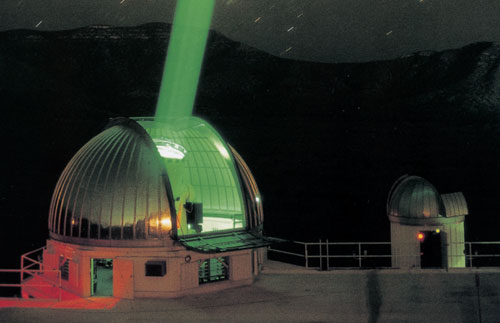Short takes on three books
By Michael Szpir, Brian Hayes, Roger Harris
Great Observatories of the World, Martin Gardner's Mathematical Games and Nature Noir
Great Observatories of the World, Martin Gardner's Mathematical Games and Nature Noir

DOI: 10.1511/2006.57.88
Great Observatories of the World. Serge Brunier and Anne-Marie Lagrange. Firefly Books, $59.95.
Future historians may look back on the giant telescopes of the 20th and 21st centuries as the secular cathedrals of our time—serving both as scientific tools and as spiritual monuments in our quest to understand the universe. Typically located on remote mountaintops, in secluded deserts or in outer space, these grand constructions are in many cases little known even to people who are otherwise scientifically literate. Indeed, even most professional astronomers had never heard of the U.S. government's highly classified Starfire Optical Range (pictured at right emitting a green laser pulse) on the Kirkland Air Force Base in New Mexico until its existence was acknowledged in 1991.

From Great Observatories of the World
In Great Observatories of the World (a translation of a 2002 French publication, Les Grands Observatoires du Monde), science writer Serge Brunier and astronomer Anne-Marie Lagrange provide a remedy for our ignorance with a series of well-written essays that describe 57 of the most significant observatories on the Earth, in space and on the drawing boards for future construction. The descriptions are accompanied by 200 photographs and illustrations, plus a brief history of the telescope and informative essays on topics such as adaptive optics, astronomy catalogs and data reduction.
The authors must have had great fun doing the background research for this book, and it shows in the liveliness of the writing and the choice of superb images. My only quibble with this handsome volume is the publisher's decision to produce the work in an oversized, picture-book format. Measuring roughly 36 x 54 centimeters when open, the book is simply too cumbersome to hold comfortably. The bulk discourages any attempts to read more than a page or two at a sitting, so the work will probably be relegated to the frivolous existence of a coffee-table book. That's a pity, because Brunier and Lagrange have produced a volume that deserves to be read.—Michael Szpir
Martin Gardner's Mathematical Games. CD-ROM edition. The Mathe-matical Association of America, $54.95.
Martin Gardner is the author of more than 60 books, including works of fiction, philosophy and literary criticism, but he is best known for the "Mathematical Games" column that he presided over in the pages of Scientific American for more than 25 years, starting in the 1950s and going on into the 1980s. The columns were republished in a series of 15 books, which are still available in various editions. Now the 15 books have also been brought together and reissued in a new format: a CD-ROM with the complete content reproduced in PDF files. The disk is accompanied by a pamphlet with appreciative essays by Donald J. Albers and Peter L. Renz.
By my count there are 311 columns. A few highlights: The article that started it all was on hexaflexagons (folded from strips of paper). When Gardner wrote about John Horton Conway's Game of Life, it created such a stir that he had to write two sequels. Another famous column introduced the world to public-key cryptography. One big advantage of the digital edition is that the text can be searched—revealing, for example, that Gardner mentions Archimedes 48 times but Zeno only 39.
For Gardner fans who still prefer their books on paper, W. W. Norton has issued The Colossal Book of Short Puzzles and Problems ($35), a compendium of more than 250 problems extracted from the columns and reorganized thematically by Dana Richards. There are also a few new puzzles from the master.—Brian Hayes
Nature Noir: A Park Ranger's Patrol in the Sierra. Jordan Fisher Smith. Houghton Mifflin, $24.
In Nature Noir, Jordan Fisher Smith relates his experiences as a park ranger for 13 years on the American River in California's Central Valley east of Sacramento. The river has been "a condemned landscape" since Congress authorized the construction of the Auburn Dam in 1965, threatening the valleys and canyons with inundation. The land to be flooded had been desecrated by miners and ranchers during and after the Gold Rush, but a series of setbacks that have delayed construction of the dam have given nature time to restore the habitat.
Smith describes this reclamation in exquisite detail. But what sets the book apart is his adept intermingling of the area's natural history with his experiences as a ranger. White-water rafters, joggers and nature lovers use the river, but its remoteness and wildness also make it a refuge for hermits, petty thieves, drug dealers and worse—the "noir" of human nature. We read of a cop who may have murdered his wife and buried her in the dam construction area, of a woman who was killed and eaten by a mountain lion and of crazies who jump off the Auburn Dam bridge. The text juxtaposes the profane and the sacred, peace and violence, sanity and madness, life and death. The concluding tragedy is Smith's own, a diagnosis of chronic Lyme disease, which ended his career as a ranger but gave him time to write a book about the river he loves.—Roger Harris
Click "American Scientist" to access home page
American Scientist Comments and Discussion
To discuss our articles or comment on them, please share them and tag American Scientist on social media platforms. Here are links to our profiles on Twitter, Facebook, and LinkedIn.
If we re-share your post, we will moderate comments/discussion following our comments policy.